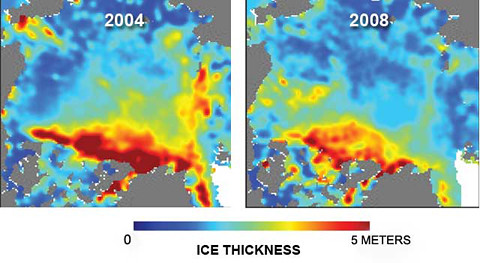More on Thinning Arctic Sea Ice
 Ron Kwok/ NASA JPL The amount of thick sea ice on the Arctic Ocean has substantially diminished in recent years. These images show winter ice thickness in meters. Click for more background.
Ron Kwok/ NASA JPL The amount of thick sea ice on the Arctic Ocean has substantially diminished in recent years. These images show winter ice thickness in meters. Click for more background. I sent some questions to some of the authors of the new study showing how much the thickness and total volume of Arctic sea ice have declined since 2003. Here’s a response from two of them, Ron Kwok and Jay Zwally of NASA.
Q. Is there any significant difference, in terms of thinking about Arctic dynamics, between volume and thickness? Is one or the other more important?
A. Thickness is important because it indicates how vulnerable the remaining ice is to further reduction and its ability to survive summer melting. Volume change includes both the area reduction (change in ice coverage, albedo, and heat absorption/reflection) and the thickness (vulnerability). Volume gives us an idea on how much freshwater is stored in Arctic sea ice — an important element in the global-Arctic hydrological cycle, i.e., the cycle of distillation due to freezing, and subsequent export, and melt. The changes in volume over a season also tell us how much ice is produced, how much heat is extracted from the ocean, how much brine is injected into the ocean as a result of ice growth and how much melt water is injected back into the ocean. As illustrated in the paper, we can now calculate the ice volume stored in perennial ice and seasonal ice. And, we are losing thick old ice via export and melt while the seasonal ice has stayed relatively unchanged.
Q. Is there any way to discriminate between the amount of the change under way that’s a function of ice flushing out of the Arctic versus melting in place? (Can this measured loss of ice still be a residual effect of the big multiyear-ice “flush” years ago?)
A. Ice export is part of the annual cycle of growth, export and melt. The paper shows that the annual ice export or flushing has not changed significantly over the last ten years. The ice “flushing” in the winter of 1994/1995 remains the highest over the satellite record (since 1979). But, the lack of replenishment of multiyear ice at the end of the summer, because the seasonal ice is not thick enough to survive the summer, seems to be a significant factor driving the recent decrease in thickness and volume. Therefore increased melting from warming appears to be driving the trend.
Q. Are there mechanisms or conditions that could conceivably turn this trend around (presumably partly a function of how much is drift versus melt)?
A. Unless there are significant changes in atmospheric circulation and cooling during the winter, it is unlikely that the Arctic ice thickness would recover. It takes years to grow ice that is several meters thick. Seasonal ice grows to only two meters every year. To get past that thickness takes many years of growth. But, this seems unlikely with current climate or with the expected additional greenhouse-gas warming.
Q. If the Arctic essentially goes to Antarctic-style sea ice (there in winter, gone in summer) does that “matter” much in the grand scheme of things?A. If we lose the summer ice cover, more heat will be absorbed by the ocean during that season. The ocean would become more difficult to cool off for ice formation during the winter -- the ocean surface has to cool off before ice production can occur. This effectively shortens the length of the ice growth season. This would have an impact on global atmospheric circulation and thus global climate. More locally, it changes the annual cycle of interactions between the Arctic ice, ocean and atmosphere system and opens the Arctic to shipping, resource exploration/extraction and potential international conflicts.
Q. What are the chances something similar could have taken place in the Arctic warm-up early in the 20th century and/or during earlier warm times in the Holocene?
Link to Dot Earth at the New York Times by Andrew Revkin: http://dotearth.blogs.nytimes.com/2009/07/08/more-on-thinning-arctic-sea-ice/#more-5501







No comments:
Post a Comment